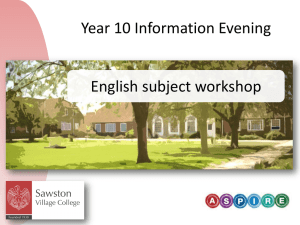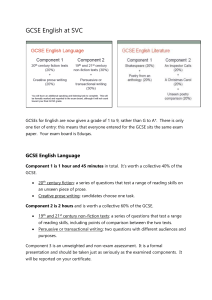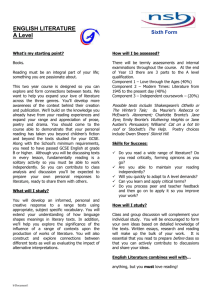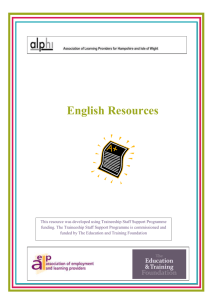Assessment objectives
advertisement
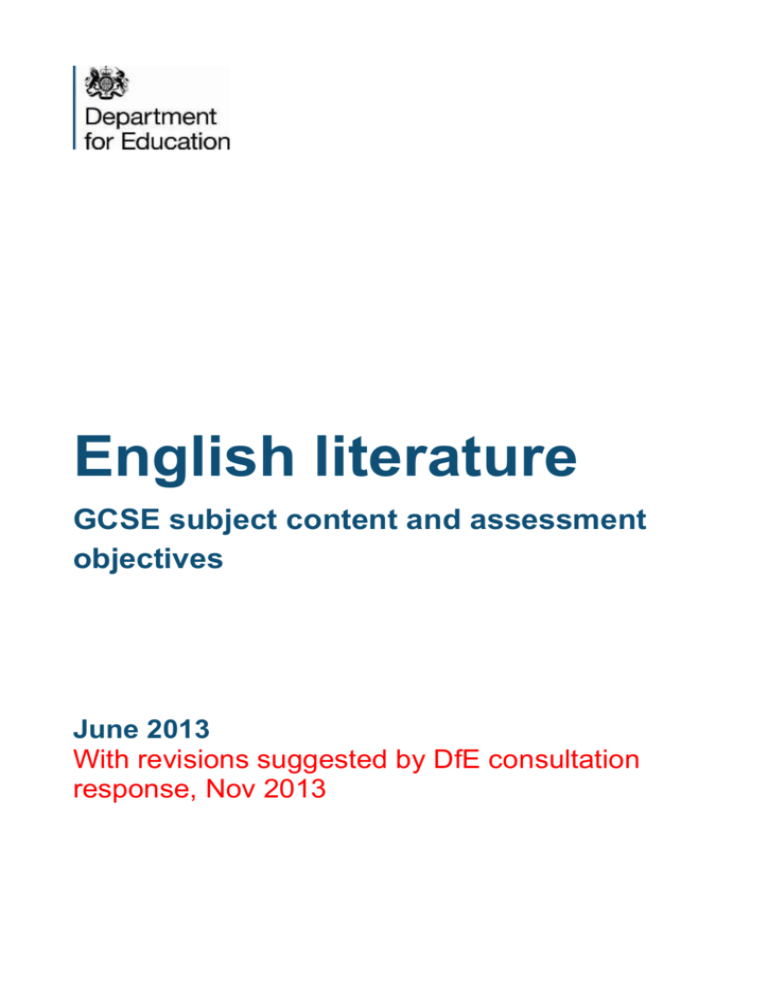
English literature GCSE subject content and assessment objectives June 2013 With revisions suggested by DfE consultation response, Nov 2013 Contents Introduction 3 Subject content 4 Assessment objectives 6 2 Introduction GCSE subject criteria set out the knowledge, understanding, skills and assessment objectives common to all GCSE specifications in a given subject. They provide the framework within which awarding organisations create the detail of their specifications, so ensuring progression from key stage 3 national curriculum requirements and the possibilities for progression to A level. Subject aims and learning outcomes This document sets out the learning outcomes and content coverage required for GCSE specifications in English literature. In subjects such as English literature, where topics are taught in progressively greater depth over the course of key stage 3 and key stage 4, GCSE outcomes may reflect or build upon subject content which is typically taught at key stage 3. There is no expectation that teaching of such content should be repeated during the GCSE course where it has already been covered at an earlier stage. GCSE specifications in English literature should develop knowledge and skills in reading, writing and critical thinking. Through literature, students have a chance to develop culturally and acquire knowledge of the best that has been thought and written. Studying GCSE English literature should ensure that students read widely for pleasure and as a preparation for studying literature at a higher level. GCSE specifications in English literature should enable students to: read a wide range of classic literature fluently and with good understanding, and make connections across their reading read in depth, critically and evaluatively, so that they are able to discuss and explain their understanding and ideas develop the habit of reading widely and often appreciate the depth and power of the English literary heritage write accurately, effectively and analytically about their reading, using Standard English acquire and use a wide vocabulary, including the grammatical terminology1 and other literary and linguistic terms they need to criticise and analyse what they read. 1 See also the glossary of grammatical terms that supports the national curriculum programmes of study for English. 3 Subject content This content sets out the full range of content for GCSE specifications in English literature. Awarding organisations may, however, use any flexibility to increase depth, breadth or context within the specified topics or to consolidate teaching of the subject content. Study of high quality English literature should be the principal focus of study for this GCSE. Digital texts must not be included. GCSE specifications in English literature should be designed on the basis that students’ reading should include whole texts. In addition to the content in the ‘Detailed study’ the examination must include questions on texts that students have not read previously (‘unseen’ texts). Scope of study GCSE specifications in English literature should require students to study: Detailed study Detailed study of a range of high quality, intellectually challenging, and substantial whole texts, which must include: at least one play by Shakespeare a selection of representative Romantic poetry at least one nineteenth-century novel a selection of poetry since 1850, including Romantic poetry British fiction or drama since the First World War. Within the range of texts above, the emphasis should be on deepening students’ understanding. To achieve balance, no more than two texts from the great tradition of English literature should be selected from each of prose, poetry and drama. The texts should be chosen with the key aim of providing students with knowledge to support both current and future study. To broaden their knowledge of literature, and their critical and comparative understanding, students should read widely to prepare them for ‘unseen’ texts in the examination. Reading comprehension and reading critically Literal and inferential comprehension: understanding a word, phrase or sentence in context; recalling and describing characters, events and settings, describing and summarising aspects of plot, setting or characterisation; distinguishing between 4 what is stated explicitly and what is implied; explaining motivation, sequence of events, and the relationship between one or more actions or events Critical reading: identifying and distinguishing between main and subsidiary themes; supporting a point of view by referring to evidence in the text; recognising the possibility of different responses to a text; using understanding of writers’ social, historical and cultural contexts to inform evaluation; making an informed personal response that derives from analysis and evaluation of the text Evaluation of a writer’s choice of vocabulary, grammatical and structural features: analysing and evaluating how language (including figurative language), structure, form and presentation contribute to quality and impact; using linguistic and literary terminology for such evaluation (such as, but not restricted to, phrase, metaphor, meter, irony and persona, synecdoche, pathetic fallacy) Comparing texts: comparing and contrasting texts studied referring to context, theme, characterisation, style and literary quality; comparing two or more unseen texts critically with respect to the above. Writing Producing clear and coherent text: writing effectively about literature for a range of purposes such as: to describe, explain, summarise, argue, analyse and evaluate; discussing and maintaining a point of view; selecting and emphasising key points; using relevant quotation and using detailed textual references Accurate Standard English: accurate spelling, punctuation and grammar. 5 Assessment objectives Assessment objectives Weighting AO1 Reading comprehension: 20 % show understanding of a word, phrase or sentence in context distinguish between what is stated explicitly and what is implied describe aspects of texts (characters, events, settings and language). AO2 Reading critically: evaluate texts, providing informed personal response to what is read analyse the techniques used by a writer to achieve specific purposes and effects relate texts to their social, historical, cultural and literary contexts compare and contrast texts (with reference to their contexts, themes, development of characterisation, styles and literary qualities). AO3 Writing: 50% (20% of which for unseen text) 30% write effectively about the texts, maintaining an appropriate discursive and literary style use relevant quotation, detailed textual references and illustrative examples in writing to explore points of view. 6 Literacy The assessment of GCSE English language provides, within it, for the assessment of key aspects of literacy. However, assessment of GCSE English literature must include assessment of spelling, punctuation and grammar in accordance with the requirements in Appendix A of the Regulations for the assessment of the quality of written communication (Ofqual, January 2012). 7 © Crown copyright 2013 You may re-use this information (excluding logos) free of charge in any format or medium, under the terms of the Open Government Licence. To view this licence, visit http://www.nationalarchives.gov.uk/doc/open-government-licence/ or e-mail: psi@nationalarchives.gsi.gov.uk. Where we have identified any third party copyright information you will need to obtain permission from the copyright holders concerned. Any enquiries regarding this publication should be sent to us at: www.education.gov.uk/contactus. This document is also available from our website at: http://www.education.gov.uk/schools/teachingandlearning/qualifications/gcses.


